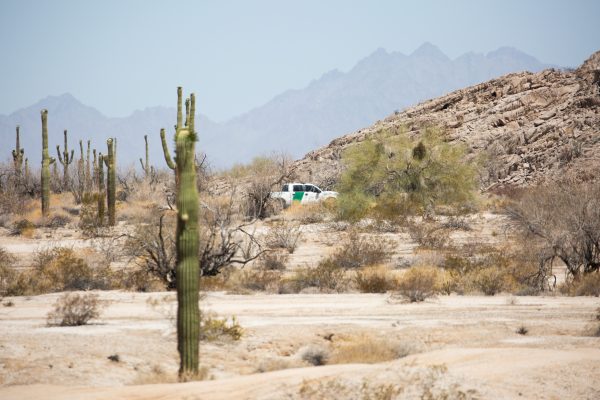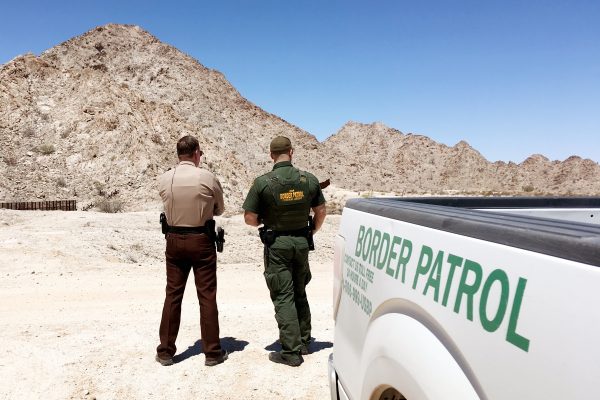““It ended up costing sheriffs in Arizona about $30 million to house these individuals that had committed crimes [and] were here illegally in this country, smuggling in heroin, dope, marijuana, cocaine,” Wilmot said.…The State Criminal Alien Apprehension Program was designed to reimburse jails with federal dollars for housing illegal aliens, but Wilmot said he was only getting back about 5 cents to the dollar. “So local tax payers still had to pick up the rest of that burden.””
 12/26/18, “Sheriff: Border Fence Helped Cut Crime in Yuma by 91 Percent,” The Epoch Times, by Yuma, Arizona
12/26/18, “Sheriff: Border Fence Helped Cut Crime in Yuma by 91 Percent,” The Epoch Times, by Yuma, Arizona“Yuma County is 5,522 square miles—larger than the state of Connecticut—and it shares 126 miles of border with Mexico. California and its Imperial Sand Dunes are just a mirage away on the western border beyond the Colorado River.
The Yuma Border Patrol Sector used to be the worst in the country for illegal crossings, until it became a poster-child for the effectiveness of a border fence.
In 2005, before the fence, more than 2,700 vehicles crossed the Colorado River and open deserts, loaded with illegal immigrants and drugs, according to Border Patrol numbers. Apprehensions steadily increased to more than 138,000 in fiscal 2005.
“Yuma battled entrenched smuggling groups for control of the border,” said Border Patrol in a video. “Mass incursions often left agents outnumbered 50 to 1. Agents were assaulted with rocks and weapons daily.”
Following the Secure Fence Act of 2006, Yuma tripled manpower and added mobile surveillance, as well as fencing and vehicle barriers. Yuma went from having 5.2 miles of fencing to 63 miles, and subsequently saw an almost 95 percent decrease in border apprehensions by 2009, when Border Patrol made about 7,000 arrests.
Ancillary Crime Down 91 Percent…
“We were able to reduce [ancillary crimes] by 91 percent,” Wilmot said. “The deaths in the desert, the rapes, the robberies, the homicides, the burglaries, the thefts.”…
However, during the Obama administration, Operation Streamline was curtailed and the 100 percent prosecution policy was halted.
“When they did away with that, they [started] coming again, and the numbers that are coming through Yuma are way back up—not where they were, but it is disturbing to see the trend increasing again and the tactics changed again, too,” Bratcher said.
“When you take away the prosecution, rather than trying to sneak through, now they just walk across and give themselves up.”
Political Agenda
Border Patrol in Yuma apprehended more than 26,000 illegal aliens in fiscal 2018.
Although the numbers pale in comparison to the Rio Grande Valley in Texas (more than 162,000 apprehensions for the same period), it is still “maddening” to Bratcher that his community suffered due to Obama-era policies.
“When they put their own political agenda above the quality of life of American citizens and Yuma citizens, what is their motivation? It makes you question that,” he said.
During the Obama era, Wilmot was forced to take matters into his own hands.
“It got to the point where, because the feds would not prosecute those drug smugglers..I had to deputize federal officers so they could actually take those cases to our County attorney and charge them with a state crime—and it was a 100 percent prosecutable case,” Wilmot said.
Wilmot said the U.S. attorney would refuse those cases, so prior to being deputized by the sheriff, the federal officers had no choice but to release the smugglers….
“The individuals would come across, the U.S. attorney’s office would not charge them…It was a revolving door. They just kept coming back, coming back, coming back.”
But prosecuting on a state or county level, instead of federal, came with a hefty price tag.
“It ended up costing sheriffs in Arizona about $30 million to house these individuals that had committed crimes [and] were here illegally in this country, smuggling in heroin, dope, marijuana, cocaine,” Wilmot said.
“When I’ve got 115 [drug] backpackers in here—it’s $130 a day for us for housing an inmate—well, they’re in here for 118 [days] to a little bit longer, on average. And then the medical cost, we have to [bear] that, too.”
The State Criminal Alien Apprehension Program was designed to reimburse jails with federal dollars for housing illegal aliens, but Wilmot said he was only getting back about 5 cents to the dollar.
“So local tax payers still had to pick up the rest of that burden.”
Wilmot said he has deputized Border Patrol agents, DEA agents, FBI agents, and Homeland Security Investigations agents.
He said he hasn’t needed to take such extraordinary measures since President Donald Trump took office, as the feds have stepped up again to prosecute criminal aliens and illegal border crossers.
“It was frustrating for us, and it was also frustrating for our federal partners that swore the same [oath] that we did to protect and serve and enforce the laws of our country,” Wilmot said. “And to see them hamstrung by politics … and that’s why I said, you can’t mix politics with public safety at all, period. It just shouldn’t happen. Unfortunately, it still does and we see it today.”…

Wilmot drove us 100 miles south from Yuma along
the Colorado River, which separates Arizona and California, then
southeast, straight along the fenceline that separates Arizona and
Mexico. Right across the fence on the Mexican side is Highway 2, which provides easy access to the border.
The terrain is bumpy, sandy desert with rocky outcrops and hills interrupting the horizon. No trees live here, only saguaro cacti, which look imposing but provide no shade. Summer temperatures are searing. It gets up to 125 degrees during the day, with ground temperatures of up to 140 degrees. There is no water….
The terrain is bumpy, sandy desert with rocky outcrops and hills interrupting the horizon. No trees live here, only saguaro cacti, which look imposing but provide no shade. Summer temperatures are searing. It gets up to 125 degrees during the day, with ground temperatures of up to 140 degrees. There is no water….
The Sinaloa cartel works the border along here—it is dominant in California and Arizona. Cartels control all the trafficking routes throughout Mexico and the ports of entry, or plazas, into the United States.
“When you’re dealing with drug smugglers and human smugglers, there is always a cost associated,” Wilmot said. “You gotta pay the cartel to utilize their area.”

[Image] Sheriff Leon Wilmot speaks to a Border Patrol agent in the desert near Yuma, Ariz., by the U.S.–Mexico border on May 25, 2018. A small section of border fence can been seen on the left. (Charlotte Cuthbertson/The Epoch Times)
He said his department has encountered many creative ways the cartels try to get illicit goods across the border…more recently, GPS drones….
“I mean, whatever the cartels can use, or their criminal element can use, to exploit our weaknesses that’s what they’re gonna use to get their product across.”
The fence abruptly stops at the foot of the rocky ranges, where it’s too steep for a fence but it’s easy to walk between the two countries.
Wilmot said the cartels employ people to sit up in the hills and act as lookouts.
“They keep ledgers and they’ve got radio systems, they’ve got solar panels, batteries, and they communicate back and forth with their partners in crime on the other side of the border. They watch Border Patrol and they watch us … and when the coast is clear, they let them come through,” Wilmot said.
“That’s how they get paid. For every successful load that gets through, that’s what they get paid for.”…
‘Get the Politics Out of It’
Wilmot says law enforcement and public safety should be looked at completely separately from politics and immigration policy issues.
“It’s two separate deals,” he said. “Politics and public safety are not synonymous at all. We need to enforce the laws of this land. If they don’t like it—which you hear all the time—they’re the lawmakers, change it. But until then, let’s do our job.”
Wilmot said most politicians that visit the border, “they’ll do their photo op, they’ll get a 20 minute briefing, and then boom, they’re done, they’re out. And that’s the problem.”
He said border security needs to be tailored to each geographic area, “because what I might need in Yuma County is not necessarily going to be needed a couple of hundred miles away over in Pima or Cochise or Santa Cruz.”
He has a suggestion for politicians in regard to border security: “Don’t do what the governors say, don’t do what the mayors say. Get with the local law enforcement leaders and then tailor it to the needs for that area. It’s the boots on the ground that know best.”
Yuma deputies work closely with local Border Patrol agents as part of a Homeland Security program called Operation Stonegarden, which provides federal funds to enhance cooperation between federal immigration authorities and local law enforcement along the border….
“What’s happening on the border ain’t coming across and staying here—it’s going throughout the United States.””
................
No comments:
Post a Comment